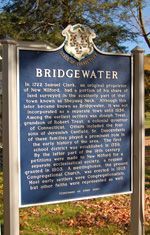About Bridgewater
History of Bridgewater, CT
 In 1722 Samuel Clark, an original proprietor of New Milford, had a portion of his share of land surveyed in the southerly part of that town known as Shepaug Neck. Although this later became known as Bridgewater, it was not incorporated as a separate town until 1856. Among the earliest settlers was Joseph Treat, grandson of Robert Treat, a colonial governor of Connecticut. Others included the four sons of Jeremiah Canfield, Sr. Descendants of these families played a prominent role in the early history of the area. The first school district was established in 1758.
In 1722 Samuel Clark, an original proprietor of New Milford, had a portion of his share of land surveyed in the southerly part of that town known as Shepaug Neck. Although this later became known as Bridgewater, it was not incorporated as a separate town until 1856. Among the earliest settlers was Joseph Treat, grandson of Robert Treat, a colonial governor of Connecticut. Others included the four sons of Jeremiah Canfield, Sr. Descendants of these families played a prominent role in the early history of the area. The first school district was established in 1758.
By the latter part of the 18th century, petitions were made to New Milford for a separate ecclesiastical society, a request granted in 1803. A meetinghouse, the present Congregational Church, was erected in 1807. Most early settlers were Congregationalists, but other faiths were represented as well. Until about 1800 a Baptist church stood on what is now called Christian Street. Episcopal worship began in private homes around 1810, and a church was built in 1836. Present St. Mark's Church was erected in 1859.
Early Bridgewater was divided into several districts, each having its own store, school, mills, and blacksmith and woodworking shops. Sheep were raised and tobacco grown. Dairy farming developed in the 19th century. Hat making flourished 1823 to 1870, when Glover Sanford & Sons had a factory on Hat Shop Hill. For some years Bridgewater was the boyhood home of Captain William D. Burnham, founder of the American Hawaiian Steamship Company. His generous bequests made possible the library and the school on Main Street that bear his name. The town was also the birthplace and place of business of Charles B. Thompson, a leading pioneer in mail-order selling. Bridgewater today is largely residential.
Source: Bridgewater Historical Society and the Connecticut Historical Commission (1979)

